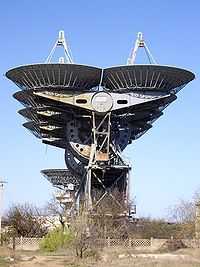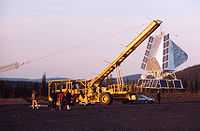Radiation astronomy/Telescopes
< Radiation astronomy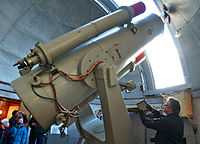
A radiation telescope is an instrument designed to collect and focus radiation so as to make distant sources appear nearer.
Astronomy
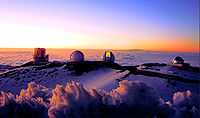
Astronomy may be accomplished by observation using personal senses, or augmented with the use of instruments. The telescope itself can be moved on or by vehicles along the ground, on water, in the air, or above the Earth's atmosphere, and throughout the nearby interplanetary medium.
Observational astronomy benefits from electronics, mechanisms, tools, and machinery.
"With its high altitude, dry environment, and stable airflow, Mauna Kea's summit is one of the best sites in the world for astronomical observation [at left], and one of the most controversial. Since the creation of an access road in 1964, thirteen telescopes funded by eleven countries have been constructed at the summit. The Mauna Kea Observatories are used for scientific research across the electromagnetic spectrum from visible light to radio, and comprise one of the world's largest facilities of their type. Their construction on a "sacred landscape",[1] replete with endangered species and ongoing cultural practices, continues to be a topic of debate and protest. Studies are underway to determine their effect on the summit ecology, particularly on the rare Wēkiu bug. It was designated a National Natural Landmark in 1972.[2][3]
"There are nine telescopes working in the visible and infrared spectrum, three in the submillimeter spectrum, and one in the radio spectrum, with mirrors or dishes ranging from 0.9 m (3.0 ft) to 25 m (82 ft).[4]"[3]
Radiation
“In physics, radiation is a process in which energetic particles or energetic waves travel through a medium or space.”[5]
Def. an action or process of throwing or sending out a traveling ray in a line, beam, or stream of small cross section is called radiation.
Def. “[t]he shooting forth of anything from a point or surface, like the diverging rays of light; as, the radiation of heat”[5] is called radiation.
Radiation that a particular telescope or a telescope array observes consists of fast moving entities from which information is gathered using spectroscopy, spatial distributions, or temporal distributions. A galaxy cluster that is moving is radiation and an astronomical object to be observed. Entities moving faster than the galaxy such as protons or photons are observables.
Astrodesy
On Earth, telescopes are positioned using geodesy, such fields as surveying, structural geology of the underlying ground, and architecture. The availability of manpower is usually missing for extraterrestrial observatories on the Moon, Mars, or Venus. On the International Space Station, manpower is often available for instrument control and use.
Instruments
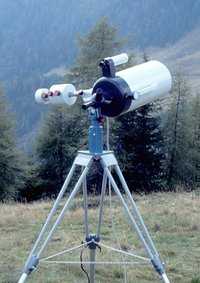
Def. “[a]ny instrument used in astronomy for observing distant objects”[6] is called a telescope.
Def. any "instrument used in astronomy for observing distant objects (such as a radio telescope)"[6] is called a telescope, or an astronomical telescope.
Aerial telescopes
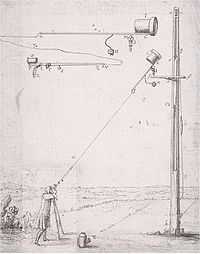
“An aerial telescope is a type of very-long-focal-length refracting telescope built in the second half of the 17th century that did not use a tube.[7] Instead, the objective was mounted on a pole, tree, tower, building or other structure on a swivel ball-joint. The observer stood on the ground and held the eyepiece, which was connected to the objective by a string or connecting rod. By holding the string tight and maneuvering the eyepiece, the observer could aim the telescope at objects in the sky.”[8]
“After about 1675, therefore, astronomers did away with the telescope tube. The objective was mounted on a building or pole by means of a ball-joint and aimed by means of a string...”[7]
Early telescopes
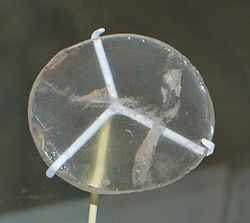
"There are indeed ancient tablets that mention astronomers' lenses supported by a golden tube to enlarge the pupil, and in Nineveh a rock crystal lens was found (Pettinato 1998). Maybe one day a new archaeological excavation will find a Babylonian telescope for the first time."[9]
Optics
"Optics involves the behavior and properties of light, including its interactions with matter and the construction of instruments that use or detect it.[10] Optics usually describes the behavior of visible, ultraviolet, and infrared light. Because light is an electromagnetic wave, other forms of electromagnetic radiation such as X-rays, microwaves, and radio waves exhibit similar properties.[10]"[11]
Colors
"[B]roadband optical photometry of Centaurs and Kuiper Belt objects from the Keck 10 m, the University of Hawaii 2.2 m, and the Cerro Tololo InterAmerican (CTIO) 1.5 m telescopes [shows] a wide dispersion in the optical colors of the objects, indicating nonuniform surface properties. The color dispersion [may] be understood in the context of the expected steady reddening due to bombardment by the ubiquitous flux of cosmic rays."[12]
Minerals
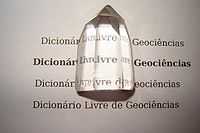
"Quartz is the second-most-abundant mineral in the Earth's continental crust, after feldspar. ... Pure quartz, traditionally called rock crystal (sometimes called clear quartz), is colorless and transparent or translucent."[13]
"Bombardment by protostellar cosmic rays may make the rock precursors of [Calcium-aluminum-rich inclusions] CAIs and chondrules radioactive, producing radionuclides found in meteorites that are difficult to obtain with other mechanisms."[14]
"Ice cores contain thin nitrate-rich layers that can be analyzed to reconstruct a history of past events before reliable observations; [this includes] data from Greenland ice cores[15] and others. These show evidence that events of [the magnitude of the solar storm of 1859—as measured by high-energy proton radiation, not geomagnetic effect—occur approximately once per 500 years, with events at least one-fifth as large occurring several times per century.[16] Less severe storms have occurred in 1921 and 1960, when widespread radio disruption was reported."[17]
"Ordinary glass is partially transparent to UVA but is opaque to shorter wavelengths, whereas silica or quartz glass, depending on quality, can be transparent even to vacuum UV wavelengths. Ordinary window glass passes about 90% of the light above 350 nm, but blocks over 90% of the light below 300 nm.[18][19][20]"[21]
Theoretical radiation astronomy telescopy
Def. "[t]he manufacture and use of telescopes"[22] is called telescopy.
Def. "[t]he manufacture and use of radio telescopes"[23] is called radiotelescopy.
Sources
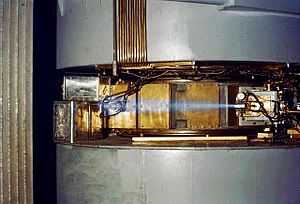

The image above shows a blue glow in the surrounding air from emitted cyclotron particulate radiation.
At right is an image that shows the blue glow resulting from a beam of relativistic electrons as they slow down. This deceleration produces synchrotron light out of the beam line of the National Synchrotron Light Source.
Bands

For elongated dust particles in cometary comas an investigation is performed at 535.0 nm (green) and 627.4 nm (red) peak transmission wavelengths of the Rosetta spacecraft's OSIRIS Wide Angle Camera broadband green and red filters, respectively.[24]
Backgrounds
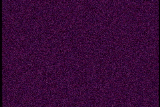
"In astronomical CCD technology, background is usually referred to the overall optical "noise" of the system, that is, the incoming light on the CCD sensor in absence of light sources. This background can originate from electronic noise in the CCD, from not-well-masked lights nearby the telescope, and so on. An exposure on an empty patch of the sky is also called a background, and is the sum of the system background level plus the sky's one."[25]
"A background frame is often the first exposure in an astronomical observation with a CCD: the frame will then be subtracted from the actual observation result, leaving in theory only the incoming light from the astronomical object being observed."[25]
Meteor telescopes
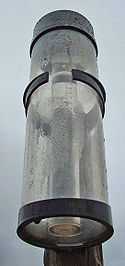
Meteor telescopes per se are often other types of telescopes, such as optical telescopes, that happen or are slewed to observe meteors.
At left is a collection device for rain on Earth as part of meteorology.
There are favorable locations on Earth, Moon and Mars where meteorites are discovered. These meteorite, or micrometeorite, locations include Antarctica and the equatorial deserts.
Cosmic-ray telescopes
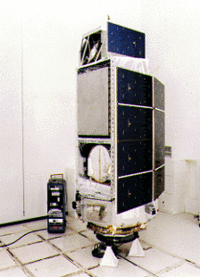


"The [HEAO 3, at right, French-Danish] C-2 experiment measured the relative composition of the isotopes of the primary cosmic rays between beryllium and iron (Z from 4 to 26) and the elemental abundances up to tin (Z=50). Cerenkov counters and hodoscopes, together with the Earth's magnetic field, formed a spectrometer. They determined charge and mass of cosmic rays to a precision of 10% for the most abundant elements over the momentum range from 2 to 25 GeV/c (c=speed of light)."[26]
"Recent measurements using the Goddard-University of New Hampshire cosmic-ray telescope [at left] on the Pioneer 10 spacecraft have revealed an anomalous spectrum of nitrogen and oxygen nuclei relative to other nuclei such as He and C, in the energy range 3-30 MeV per nucleon."[27]
Neutron telescopes
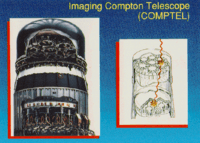
"In addition to observing gamma rays from a solar flare, [ the Imaging Compton Telescope] COMPTEL is also capable of detecting solar neutrons. Neutron interactions within the instrument occur when an incident solar neutron elastically scatters off a hydrogen nucleus in the liquid scintillator of an upper D1 module. The scattered neutron may then interact and deposit all or a portion of its energy in one of the lower D2 modules, providing the internal trigger signal necessary for a double scatter event. The energy of the scattered neutron is deduced from its time of flight from the upper to lower detector, which is summed with the energy measured for the recoil proton in the upper D1 module to obtain the energy of the incident solar neutron. The computed scatter angle of the neutron, as with gamma rays, yields an event circle on the sky, which can be further constrained since the true source of the detected neutrons is assumed to be the Sun."[28]
Electron telescopes
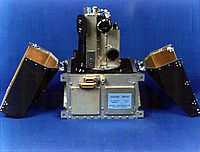
"[The] two bi-directional, solid-state detector telescopes [of the Galileo Orbiter are] mounted on a platform which [is] rotated by a stepper motor into one of eight positions. This rotation of the platform, combined with the spinning of the orbiter in a plane perpendicular to the platform rotation, [permits] a 4-pi [or 4π] steradian coverage of incoming [electrons]. The forward (0 degree) ends of the two telescopes [have] an unobstructed view over the [4π] sphere or [can] be positioned behind a shield which not only [prevents] the entrance of incoming radiation, but [contains] a source, thus allowing background corrections and in-flight calibrations to be made. ... The 0 degree end of the [Low-Energy Magnetospheric Measurements System] LEMMS [uses] magnetic deflection to separate incoming electrons and ions. The 180 degree end [uses] absorbers in combination with the detectors to provide measurements of higher-energy electrons ... The LEMMS [provides] measurements of electrons from 15 keV to greater than 11 MeV ... in 32 rate channels."[29]
Positron telescopes
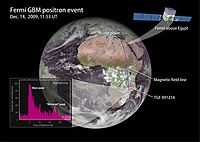
The image at right contains a picture of the Fermi gamma-ray telescope that performed observations of positrons from their terrestrial gamma-ray flashes.
The positrons are not directly observed by the INTEGRAL space telescope, but "the 511 keV positron annihilation emission is".[30]
Neutrinos telescopes
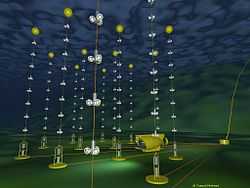
"ANTARES [illustrated at right] is the name of a neutrino detector residing 2.5 km under the Mediterranean Sea off the coast of Toulon, France. It is designed to be used as a directional Neutrino Telescope to locate and observe neutrino flux from cosmic origins in the direction of the Southern Hemisphere of the Earth, a complement to the southern hemisphere neutrino detector IceCube that detects neutrinos from the North."[31]
"The IceCube Neutrino Observatory (or simply IceCube) [at left] is a neutrino telescope constructed at the Amundsen-Scott South Pole Station in Antarctica.[1] Similar to its predecessor, the Antarctic Muon And Neutrino Detector Array (AMANDA), IceCube contains thousands of spherical optical sensors called Digital Optical Modules (DOMs), each with a photomultiplier tube (PMT)[32] and a single board data acquisition computer which sends digital data to the counting house on the surface above the array.[33] IceCube was completed on 18 December, 2010, New Zealand time.[34]"[35]
Gamma-ray telescopes

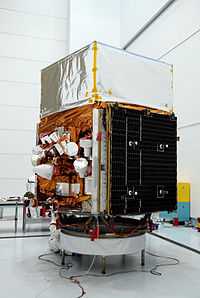
"The Imaging Compton Telescope, (COMPTEL) by the Max Planck Institute for Extraterrestrial Physics, the University of New Hampshire, Netherlands Institute for Space Research, and ESA's Astrophysics Division was tuned to the 0.75-30 MeV energy range and determined the angle of arrival of photons to within a degree and the energy to within five percent at higher energies. The instrument had a field of view of one steradian. For cosmic gamma-ray events, the experiment required two nearly simultaneous interactions, in a set of front and rear scintillators. Gamma rays would Compton scatter in a forward detector module, where the interaction energy E1, given to the recoil electron was measured, while the Compton scattered photon would then be caught in one of a second layer of scintillators to the rear, where its total energy, E2, would be measured. From these two energies, E1 and E2, the Compton scattering angle, angle θ, can be determined, along with the total energy, E1 + E2, of the incident photon. The positions of the interactions, in both the front and rear scintillators, was also measured. The vector, V, connecting the two interaction points determined a direction to the sky, and the angle θ about this direction, defined a cone about V on which the source of the photon must lie, and a corresponding "event circle" on the sky."[36]
"COMPTEL's upper layer of detectors are filled with a liquid scintillator which scatters an incoming gamma-ray photon according to the Compton Effect. This photon is then absorbed by NaI crystals in the lower detectors. The instrument records the time, location, and energy of the events in each layer of detectors which makes it possible to determine the direction and energy of the original gamma-ray photon and reconstruct an image and energy spectrum of the source."[37]
"The Large Area Telescope (LAT) [of the Fermi Gamma-ray Space Telescope ] detects individual gamma rays using technology similar to that used in terrestrial particle accelerators. Photons hit thin metal sheets, converting to electron-positron pairs, via a process known as pair production. These charged particles pass through interleaved layers of silicon microstrip detectors, causing ionization which produce detectable tiny pulses of electric charge. Researchers can combine information from several layers of this tracker to determine the path of the particles. After passing through the tracker, the particles enter the calorimeter, which consists of a stack of caesium iodide scintillator crystals to measure the total energy of the particles. The LAT's field of view is large, about 20% of the sky. The resolution of its images is modest by astronomical standards, a few arc minutes for the highest-energy photons and about 3 degrees at 100 MeV. The LAT is a bigger and better successor to the EGRET instrument on NASA's Compton Gamma Ray Observatory satellite in the 1990s."[38]
"For X-rays, the index of refraction is defined by Rayleigh scattering,"[39] especially in the use of Wolter telescopes.
"[T]he strength of the effect drops off as the inverse square of the X-ray energy. This means that at high X-ray energies – and on into low gamma-ray energies – the radiation is not bent enough for a lens to work effectively."[39]
"[T]he index of refraction starts to make a comeback at energies greater than about 700 keV. What is more, while the index of refraction is negative for X-rays, it becomes positive for gamma rays."[39]
"What is new now is that with gamma rays we can really address the extremely high electric field of the nucleus," with Delbrück scattering.[40]
"The measurements indicate that there exists an index of refraction for gamma-ray energies that is substantially larger than people believed before".[41]
"Materials with nuclei that have a large positive charge – such as gold – should be ideal for making gamma-ray lenses".[39]
X-ray telescopes
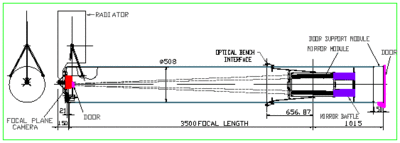
"X-ray telescopes can use a variety of different designs to image X-rays. The most common methods used in X-ray telescopes are grazing incidence mirrors and coded apertures. The limitations of X-ray optics result in much narrower fields of view than visible or UV telescopes."[42]
An extreme example of a reflecting telescope is demonstrated by the grazing incidence X-ray telescope (XRT) of the Swift satellite that focuses X-rays onto a state-of-the-art charge-coupled device (CCD), in red at the focal point of the grazing incidence mirrors (in black at the right).
"A Wolter telescope is a telescope for X-rays using only grazing incidence optics. ... X-rays mirrors can be built, but only if the angle from the plane of reflection is very low (typically 10 arc-minutes to 2 degrees)[43]. These are called glancing (or grazing) incidence mirrors. In 1952, Hans Wolter outlined three ways a telescope could be built using only this kind of mirror.[44][45]. Not surprisingly, these are called Wolter telescopes of type I, II, and III. Each has different advantages and disadvantages.[46]"[47]
Optical telescopes
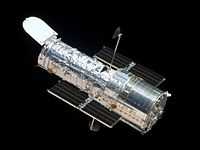
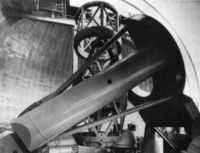
Def. "[a] monocular optical instrument possessing magnification for observing distant objects", per Wiktionary telescope, is called a telescope.
The Hubble Space Telescope (HST) is an excellent example of a radiation astronomy satellite designed for more than one purpose: the various astronomies of optical astronomy.
The HST is an optical astronomy telescope that “incorporated a set of 48 filters isolating spectral lines of particular astrophysical interest."[48]
Most radiation telescopes, especially optical telescopes, combine a variety of lenses, mirrors, active and adaptive optics, filters, detectors, mounts, image processing, and observatories, in many locations.
Active optics
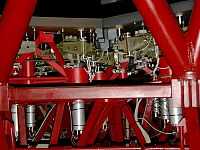
“Active optics is a technology used with reflecting telescopes developed in the 1980s[49], which actively shapes a telescope's mirrors to prevent deformation due to external influences such as wind, temperature, mechanical stress. Without active optics, the construction of 8 metre class telescopes is not possible, nor would telescopes with segmented mirrors be feasible.”[50]
“[T]elescopes built since the 1980s use very thin mirrors ... which are too thin to keep themselves rigidly in the correct shape. Instead, an array of actuators behind the mirror keeps it in an optimal shape. The telescope may also be segmented into many small mirrors, preventing most of the gravitational distortion that occurs in large, thick mirrors. The combination of actuators, a quality-of-image detector, and a real-time computer program to move the actuators to obtain the best possible image is termed active optics. The name active optics means that the system keeps a mirror (usually the primary) in its optimal shape against all environmental factors such as gravity (at different telescope inclinations), wind, temperature changes, telescope axis deformation, et cetera. Active optics correct all factors that may affect image quality at timescales of one second or more. The telescope is therefore actively still, in its optimal shape.”[50]
Adaptive optics
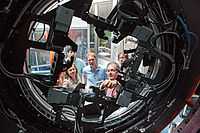
Def. "[a]n optical system in telescopes that reduces atmospheric distortion by dynamically measuring and correcting wavefront aberrations in real time, often by using a deformable mirror"[51] is called adaptive optics.
"Already it has allowed ground-based telescopes to produce images with sharpness rivalling those from the Hubble Space Telescope. The technique is expected to revolutionize the future of ground-based optical astronomy."[52]
At right is an image of the adaptive optics of the GRAAL. GRAAL stands for GRound layer Adaptive optics Assisted by Lasers. It will use the technique of adaptive optics to improve the quality of images by compensating for turbulence in the lower layers of the atmosphere, up to an altitude of 1 kilometre. GRAAL, which will be installed on ESO’s Very Large Telescope (VLT) on Cerro Paranal in Chile, is designed to improve the vision of the VLT’s already excellent HAWK-I camera even further. Currently, HAWK-I operates without adaptive optics. Installing GRAAL will improve the sharpness of HAWK-I’s images, and reduce the exposure times needed by up to a factor of two.
Refracting telescopes
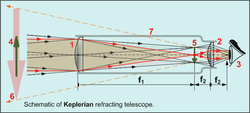
"The Keplerian Telescope, invented by Johannes Kepler in 1611, is an improvement on Galileo's design.[53] It uses a [plano]convex lens as the eyepiece instead of Galileo's [double] concave one. The advantage of this arrangement is [that] the rays of light emerging from the eyepiece are converging. This allows for a much wider field of view and greater eye relief but the image for the viewer is inverted. Considerably higher magnifications can be reached with this design but to overcome aberrations the simple objective lens needs to have a very high f-ratio"[54].
"All refracting telescopes use the same principles. The combination of an objective lens 1 and some type of eyepiece 2 is used to gather more light than the human eye could collect on its own, focus it 5, and present the viewer with a brighter, clearer, and magnified virtual image 6."[54]
Reflecting telescopes
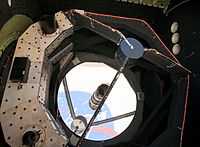
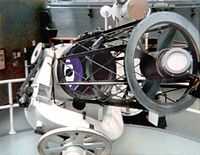
"A reflecting telescope (also called a reflector) is an optical telescope which uses a single or combination of curved mirrors that reflect light and form an image."[55]
Catadioptric telescopes
Def. “optical systems that employ both refractive (dioptric) and reflective (catoptric) elements”[56] are called catadioptric optical systems.
Def. “[t]he construction and use of catadioptric lenses and systems”[57] is called catadioptrics.
Dobsonian telescopes
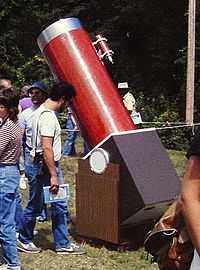
"A Dobsonian telescope is an alt-azimuth mounted newtonian telescope design popularized by the [amateur astronomy] John Dobson starting in the 1960s. Dobson's telescopes featured a simplified mechanical design that was easy to manufacture from readily available components to create a large, portable, low-cost telescope. The design is optimized for visually observing faint deep sky objects such as nebulae. This type of observation requires a large objective diameter (i.e. light-gathering power) of relatively short focal length and portability for travel to relatively less light polluted locations.[58][59]"[60]
Schmidt telescopes
.svg.png)
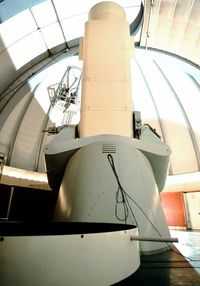
At the top of this lecture/article is the Schmidt Telescope at the former Brorfelde Observatory. It is now used by amateur astronomers. The telescope from 1966 is still located in the same building in Brorfelde as originally. Today the telescope has a 77 cm mirror and a digital 2048x2048 pixel CCD-camera. Originally photographic film was used, and in the lower right part an engineer is showing the former film-box, which was then placed behind the locker at the center of the telescope (at the prime focus).
"A Schmidt camera, also referred to as the Schmidt telescope, is a catadioptric astrophotographic [optical] telescope designed to provide wide fields of view with limited aberrations."[61]
Maksutov telescopes


"The Maksutov is a catadioptric telescope design that combines a spherical mirror with a weakly negative meniscus lens in a design that takes advantage of all the surfaces being nearly "spherically symmetrical".[62] The negative lens is usually full diameter and placed at the entrance pupil of the telescope (commonly called a "corrector plate" or "meniscus corrector shell"). The design corrects the problems of off-axis aberrations such as coma found in reflecting telescopes while also correcting chromatic aberration."[63]
Ultraviolet telescopes
"The Extreme ultraviolet Imaging Telescope (EIT) is an instrument on the SOHO spacecraft used to obtain high-resolution images of the solar corona in the ultraviolet range. The EIT instrument is sensitive to light of four different wavelengths: 17.1, 19.5, 28.4, and 30.4 nm, corresponding to light produced by highly ionized iron (XI)/(X), (XII), (XV), and helium (II), respectively. EIT is built as a single telescope with a quadrant structure to the entrance mirrors: each quadrant reflects a different colour of EUV light, and the wavelength to be observed is selected by a shutter that blocks light from all but the desired quadrant of the main telescope."[64]
"EIT is the first long-duration instrument to use normal incidence multilayer coated optics to image the Sun in extreme ultraviolet. This portion of the spectrum is extremely difficult to reflect, as most matter absorbs the light very strongly. Conventionally these wavelengths have been reflected either using grazing incidence (as in a Wolter telescope for imaging X-rays) or a diffraction grating (as ... flown on Skylab in the mid 1970s)."[64]
"[V]acuum deposition technology allows mirrors to be coated with extremely thin layers of nearly any material. The multilayer mirrors in an EUV telescope are coated with alternate layers of a light "spacer" element (such as silicon) that absorbs EUV light only weakly, and a heavy "scatterer" element (such as molybdenum) that absorbs EUV light very strongly. Perhaps 100 layers of each type might be placed on the mirror, with a thickness of around 10 nm each. The layer thickness is tightly controlled, so that at the desired wavelength, reflected photons from each layer interfere constructively. In this way, reflectivities of up to ~50% can be attained."[64]
"The multilayer technology allows conventional telescope forms (such as the Cassegrain or Ritchey-Chretien designs) to be used in a novel part of the spectrum."[64]
Visual telescopes
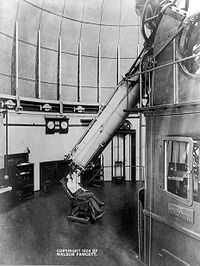
“I think everyone can conjure up a mental image of astronomers at every level and place in history, gazing through the eyepieces of their telescopes at sights far away - true visual astronomy.”[65]
Astronomical filters
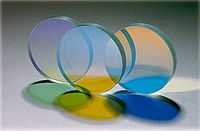
“An astronomical filter is sometimes a telescope accessory used ... to simply enhance the details of celestial objects ... [or as part of the photometric system of] filters ... to understand the astrophysics (such as stellar classification and placement of a celestial body on its Wein Curve), occurring for the object in a given bandpass via photometry.”[66]
“Most astronomical filters work by blocking a specific part of the color spectrum above and below a bandpass, significantly increasing the signal to noise of the [interesting] wavelengths, and so making the object more visible, 'contrasty', or defined. While ... color filters transmit certain colors from the spectrum and are usually used for observation of the planets and the Moon, ... polarizing filters work by adjusting the brightness, and are usually used for the Moon. The broadband and narrowband filters transmit the wavelengths that are emitted by ... hydrogen and oxygen atoms, and are frequently used for reducing light pollution.[1]”[66]
Infrared telescopes
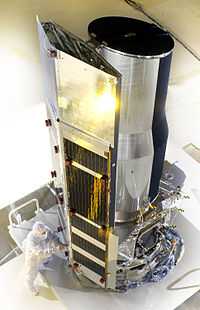
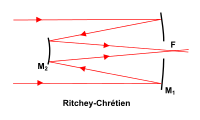
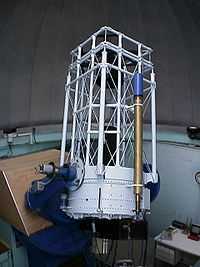
The Spitzer telescope is a "Ritchey–Chrétien telescope ... a specialized Cassegrain telescope ... that has a hyperbolic primary mirror and a hyperbolic secondary mirror designed to eliminate optical errors (coma). They have [a] large field of view free of optical errors compared to a more conventional reflecting telescope configuration."[67]
"The radii of curvature of the primary and secondary mirrors, respectively, in a two-mirror Cassegrain configuration are
and
where
-
 is the effective focal length of the system,
is the effective focal length of the system, -
 is the back focal length (the distance from the secondary to the focus), and
is the back focal length (the distance from the secondary to the focus), and -
 is the distance between the two mirrors."[67]
is the distance between the two mirrors."[67]
"If, instead of  and
and  , the known quantities are the focal length of the primary mirror,
, the known quantities are the focal length of the primary mirror,  , and the distance to the focus behind the primary mirror,
, and the distance to the focus behind the primary mirror,  , then
, then  and
and  ."[67]
."[67]
"For a Ritchey–Chrétien system, the conic constants  and
and  of the two mirrors are chosen so as to eliminate third-order spherical aberration and coma; the solution is
of the two mirrors are chosen so as to eliminate third-order spherical aberration and coma; the solution is
and
where  is the secondary magnification.[68] Note that
is the secondary magnification.[68] Note that  and
and  are less than
are less than  (since
(since  ), so both mirrors are hyperbolic. (The primary mirror is typically quite close to being parabolic, however.)"[67]
), so both mirrors are hyperbolic. (The primary mirror is typically quite close to being parabolic, however.)"[67]
"The hyperbolic curvatures are difficult to test, especially with equipment typically available to amateur telescope makers or laboratory-scale fabricators; thus, older telescope layouts predominate in these applications. However, professional optics fabricators and large research groups test their mirrors with interferometers. A Ritchey–Chrétien then requires minimal additional equipment, typically a small optical device called a null corrector that makes the hyperbolic primary look spherical for the interferometric test."[67]
The telescope at left is the early Ritchey–Chrétien 1.0 meter telescope at NOFS at the United States Naval Observatory Flagstaff Station.
Submillimeter telescopes
.jpg)
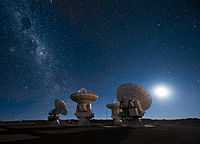
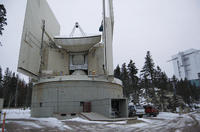
The Atacama Large Millimeter/submillimeter Array (ALMA) is being constructed at an altitude of 5000 m on the Chajnantor plateau in the Atacama Desert of Chile. This is one of the driest places on Earth and this dryness, combined with the thin atmosphere at high altitude, offers superb conditions for observing the Universe at millimetre and submillimetre wavelengths. At these long wavelengths, astronomers can probe, for example, molecular clouds, which are dense regions of gas and dust where new stars are born when a cloud collapses under its own gravity. Currently, the Universe remains relatively unexplored at submillimetre wavelengths, so astronomers expect to uncover many new secrets about star formation, as well as the origins of galaxies and planets.
"ALMA began scientific observations in the second half of 2011 and the first images were released to the press on 3 October 2011. The array has been fully operational since March 2013.[69]"[70]
“The Submillimeter Telescope (SMT), formerly known as the Heinrich Hertz Submillimeter Telescope [at lower right], is a submillimeter wavelength radio telescope located on Mount Graham, Arizona. It is a 10-meter-wide parabolic dish inside a building to protect it from bad weather. The building front doors and roof are opened when the telescope is in use. ... The dryness of the air around and above Mt. Graham is particulatly vital for EHF (extremely low wavelength radio) and far-infrared observations - a region of the spectrum where the electromagnetic waves are strongly attenuated by any water vapor or clouds in the air.”[71]
Radio telescopes
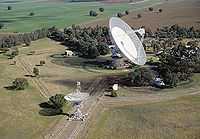
Def. “[a] device for studying astronomical sources of radio waves”[72] is called a radio telescope.
“A radio telescope is a form of directional radio antenna, [as] used in tracking and collecting data from satellites and space probes ... that [operates] in the radio frequency portion of the electromagnetic spectrum ... Radio telescopes are typically large parabolic ("dish") antennas used singly or in an array. Radio observatories are preferentially located far from major centers of population to avoid electromagnetic interference (EMI) from radio, TV, radar, and other EMI emitting devices.”[73]
Microwave telescopes
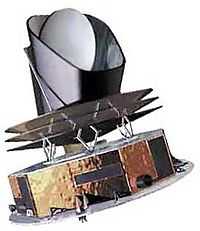
"The basic scientific goal of the Planck mission is to measure [cosmic microwave background] CMB anisotropies at all angular scales larger than 10 arcminutes over the entire sky with a precision of ~2 parts per million. The model payload consists of a 1.5 meter off-axis telescope with two focal plane arrays of detectors sharing the focal plane. Low frequencies will be covered by 56 tuned radio receivers sensitive to 30-100 GHz, while high frequencies will be covered by 56 bolometers sensitive to 100-850 GHz."[74]
Radar telescopes
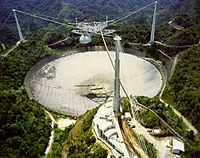
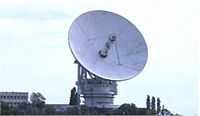
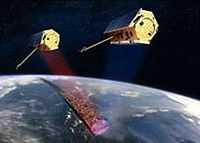
The image at right shows planetary radar telescopes at Pluton, USSR, in 1960.
The "Arecibo Observatory in Puerto Rico [is] the world's largest, and most sensitive, single-dish radio telescope."[75]
"The 1,000-foot-diameter (305 meters) Arecibo telescope [... provides] access to state-of-the-art observing for scientists in radio astronomy, solar system radar and atmospheric studies, and the observatory has the unique capability for solar system and ionosphere (the atmosphere's ionized upper layers) radar remote sensing."[75]
"The telescope has three radar transmitters, with effective isotropic radiated powers of 20 TW at 2380 MHz, 2.5 TW (pulse peak) at 430 MHz, and 300 MW at 47 MHz. The telescope is a spherical reflector, not a parabolic reflector. To aim the telescope, the receiver is moved to intercept signals reflected from different directions by the spherical dish surface. A parabolic mirror would induce a varying astigmatism when the receiver is in different positions off the focal point, but the error of a spherical mirror is the same in every direction."[76]
At second lower left is the Evpatoria RT-70 radar telescope in the Ukraine.
At lower right is an artist's impression of the two radar satellites TerraSAR-X and TanDEM-X.
Radio interferometry
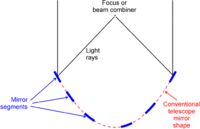
“An astronomical interferometer is an array of telescopes or mirror segments acting together to probe structures with higher resolution by means of interferometry. The benefit of the interferometer is that the angular resolution of the instrument is nearly that of a telescope with the same aperture as a single large instrument encompassing all of the individual photon-collecting sub-components. The drawback is that it does not collect as many photons as a large instrument of that size. Thus it is mainly useful for fine resolution of the more luminous astronomical objects, such as close binary stars.”[77]
“Very Long Baseline Interferometry uses a technique related to the closure phase to combine telescopes separated by thousands of kilometers to form a radio interferometer with the resolution which would be given by a single dish which was thousands of kilometers in diameter. ... Astronomical interferometers can produce higher resolution astronomical images than any other type of telescope. At radio wavelengths image resolutions of a few micro-arcseconds have been obtained”[77].
Superluminal telescopes
"The Cherenkov telescopes do not actually detect the gamma rays directly but instead detect the flashes of visible light [Cherenkov radiation] produced when gamma rays are absorbed by the Earth's atmosphere.[78]"[79]
Plasma-object telescopes
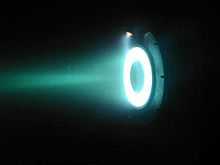
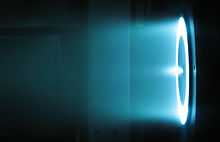
"In spacecraft propulsion, a Hall thruster is a type of ion thruster in which the propellant is accelerated by an electric field. Hall thrusters trap electrons in a magnetic field and then use the electrons to ionize propellant, efficiently accelerate the ions to produce thrust, and neutralize the ions in the plume. Hall thrusters are sometimes referred to as Hall effect thrusters or Hall current thrusters. Hall thrusters are often regarded as a moderate specific impulse (1,600 s) space propulsion technology. ... Hall thrusters operate on a variety of propellants, the most common being xenon. Other propellants of interest include krypton, argon, bismuth, iodine, magnesium, and zinc."[80]
While these thrusters are not plasma-object telescopes, they may serve to maneuver or slew a space telescope. As sources of blue light they mat serve as calibrated light sources.
Gaseous-object telescopes

The "Sun Gun Telescope [is] designed so that large groups of people can view the sun safely - in particular it was created as a way to encourage children to become interested in astronomy. With this safe and portable device, both amateur science enthusiasts and professionals alike can observe sun spots."[81]
The "Sun Gun [has] a 60mm dia. 900mm fl. optical tube which is mounted inside a 3" PVC which is in turn connected to a 20" plastic flower planter. A rear projection screen is ... mounted on the top of the flower planter. The entire Sun Gun can be made from items easily found at most local hardware stores. The scope itself is an inexpensive 60mm refractor available from many sources."[81]
Liquid-object telescopes
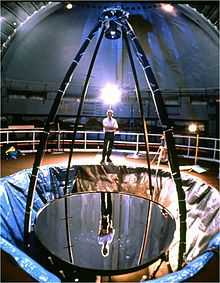
"Liquid mirror telescopes are telescopes with mirrors made with a reflective liquid. The most common liquid used is mercury, but other liquids will work as well (for example, low melting alloys of gallium). The container for the liquid is rotating so that the liquid assumes a paraboloidal shape. A paraboloidal shape is precisely the shape needed for the primary mirror of a telescope. The rotating liquid assumes the paraboloidal shape regardless of the container's shape. To reduce the amount of liquid metal needed, and thus weight, a rotating mercury mirror uses a container that is as close to the necessary parabolic shape as possible. Liquid mirrors can be a low cost alternative to conventional large telescopes. Compared to a solid glass mirror that must be cast, ground, and polished, a rotating liquid metal mirror is much less expensive to manufacture."[82]
A "telescope with a liquid metal mirror can only be used [as a] zenith telescope that looks straight up".[82]
Hydrogen telescopes
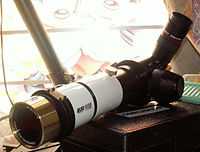
"In the field of amateur astronomy ... Amateurs use ... hydrogen-alpha filter systems".[83]
Alloys
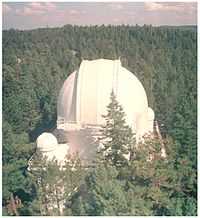
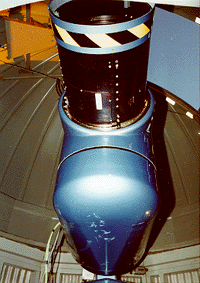
"The NASA-LMT was 3 m (9.8 ft) aperture liquid mirror telescope located in NODO's main dome. It consisted of a 3 m diameter parabolic dish that held 4 U.S. gallons (15 l) of a highly reflective liquid metal, mercury, spinning at a rate of 10 rpm, with sensors mounted above on a fixed structure. Due to the primary mirror's material, the NASA-LMT was configured as a zenith telescope. Using 20 narrowband filters, it cataloged space debris in Earth's orbit."[84]
"The 32 cm (13 in) CCD Debris Telescope (CDT) was a portable Schmidt camera equipped with a 512×512 pixel charge-coupled device (CCD) sensor. It operated at NODO from October of 1997 until December of 2001, and was used to characterize debris at or near geosynchronous orbit."[84]
Meteorites

"On September 20, the X-Ray Laboratory at the Faculty of Geological Sciences, Mayor de San Andres University, La Paz, Bolivia, published a report of their analysis of a small sample of material recovered from the impact site. They detected iron, nickel, cobalt, and traces of iridium — elements characteristic of the elemental composition of meteorites. The quantitative proportions of silicon, aluminum, potassium, calcium, magnesium, and phosphorus are incompatible with rocks that are normally found at the surface of the Earth.[85]"[86]
Shelters
"Telescope domes have a slit or other opening in the roof that can be opened during observing, and closed when the telescope is not in use. In most cases, the entire upper portion of the telescope dome can be rotated to allow the instrument to observe different sections of the night sky. Radio telescopes usually do not have domes."[87]
Spectroscopy
"Astronomical spectroscopy is the technique of spectroscopy used in astronomy. The object of study is the spectrum of electromagnetic radiation, including visible light, which radiates from stars and other celestial objects. Spectroscopy can be used to derive many properties of distant stars and galaxies, such as their chemical composition, but also their motion by Doppler shift measurements."[88]
Spectrometers
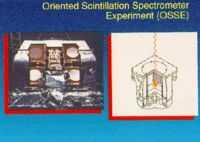
"The Oriented Scintillation Spectrometer Experiment (OSSE) will conduct a broad range of observations in the 0.05-250 MeV energy range. Major emphasis is placed on scientific objectives in the 0.1-10.0 MeV region with a limited capability above 10 MeV, primarily for observations of solar gamma-rays and neutrons and observations of high-energy emission from pulsars."[28]
Planetary telescopes
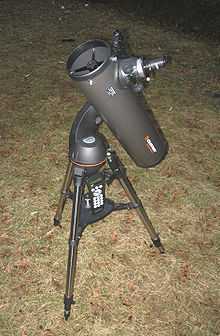
"In amateur astronomy, "GoTo" refers to a type of telescope mount and related software which can automatically point a telescope to astronomical objects that the user selects. Both axes of a GoTo mount are motor driven and are controlled by either a microprocessor-based integrated controller or a personal computer, as opposed to the single axis semi-automated tracking of a traditional clock drive mount. This allows the user to command the mount to point the telescope to a right ascension and declination that the user inputs or have the mount itself point the telescope to objects in a pre-programmed data base including ones from the Messier catalogue, the New General Catalogue, and even major solar system bodies (the Sun, Moon, and planets)."[89]
Solar telescopes
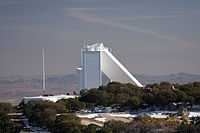
"A solar telescope is a special purpose telescope used to observe the Sun. Solar telescopes usually detect light with wavelengths in, or not far outside, the visible spectrum."[83]
Asteroid telescopes
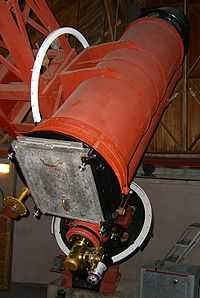
The Lowell astrograph imaged at right is a 13-inch, f/5.3 astrograph at Lowell Observatory, a refractor with a 3 element Cooke triplet lens.[90]) that was used in the discovery of Pluto.
"An astrograph (astrographic camera) is a telescope designed for the sole purpose of astrophotography. Astrographs are usually used in wide field surveys of the night sky as well as detection of objects such as asteroids, meteors, and comets."[91]
Comet-seeker telescopes
"A comet seeker is a type of small telescope adapted especially to searching for comets: commonly of short focal length and large aperture, in order to secure the greatest brilliancy of light."[92]
Stellar telescopes
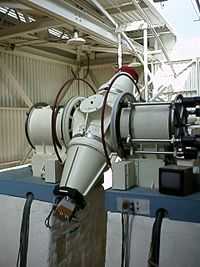
"The meridian circle is an instrument for timing of the passage of stars across the local meridian, an event known as a transit, while at the same time measuring their angular distance from the nadir. These are special purpose telescopes mounted so as to allow pointing only in the meridian, the great circle through the north point of the horizon, the zenith, the south point of the horizon, and the nadir. Meridian telescopes rely on the rotation of the Earth to bring objects into their field of view and are mounted on a fixed, horizontal, east-west axis."[93]
"A modern day example of this type of telescope is the 8 inch (~0.2m) Flagstaff Astrometric Scanning Transit Telescope (FASTT) at the [United States Naval Observatory] USNO Flagstaff Station Observatory.[94] Modern meridian circles are usually automated. The observer is replaced with a [Charge-coupled device] CCD camera. As the sky drifts across the field of view, the image built up in the CCD is clocked across (and out of) the chip at the same rate. This allows some improvements:[95]"[93]
Galactic telescopes
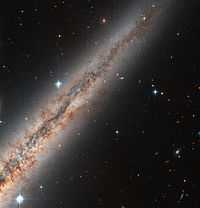
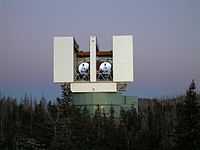
The Large Binocular Telescope [at left] is "located on Mount Graham (10,700-foot (3,300 m)) in the Pinaleno Mountains of southeastern Arizona, and is a part of the Mount Graham International Observatory."[96]
"The first image taken [shown at right] combined ultraviolet and green light, and emphasizes the clumpy regions of newly formed hot stars in the spiral arms."[96]
Locations on Earth
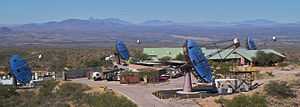
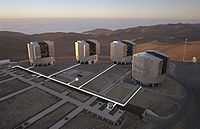
"VERITAS (Very Energetic Radiation Imaging Telescope Array System) is a ground-based gamma-ray instrument operating at the Fred Lawrence Whipple Observatory (FLWO) in southern Arizona, USA. It is an array of four 12m optical reflectors for gamma-ray astronomy in the GeV - TeV energy range. These imaging Cherenkov [a bluish light] telescopes are deployed such that they have the highest sensitivity in the VHE energy band (50 GeV - 50 TeV), with maximum sensitivity from 100 GeV to 10 TeV. This VHE observatory effectively complements the NASA Fermi mission."[97]
The Collaboration between Australia and Nippon for a Gamma Ray Observatory in the Outback, (CANGAROO) is for "[v]ery high energy cosmic gamma ray observation by telescope [detecting Cherenkov light]. [It is] [l]ocated on the Woomera Prohibited Area in South Australia. [98]"[99]
"The Very Large Telescope (VLT) is a telescope operated by the European Southern Observatory on Cerro Paranal in the Atacama Desert of northern Chile. ... The UTs are equipped with a large set of instruments permitting observations to be performed [in] the near-ultraviolet" ... It includes large-field imagers, adaptive optics corrected cameras and spectrographs, as well as high-resolution and multi-object spectrographs and covers a broad spectral region, from [the] deep ultraviolet (300 nm)".[100]
Recent history
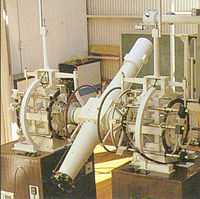
The recent history period dates from around 1,000 b2k to present.
The 6-inch transit circle [imaged at right] of the U.S. Naval Observatory was built by Warner and Swasey in 1898.
Coded apertures
"Some X-ray telescopes use coded aperture imaging. This technique uses a flat aperture grille in front of the detector, which weighs much less than any kind of focusing X-ray lens, but requires considerably more post-processing to produce an image."[101]
Mirrors
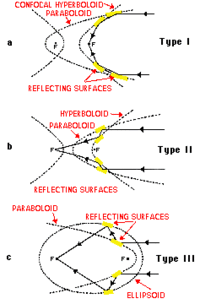
"The mirrors can be made of ceramic or metal foil.[102] The most commonly used grazing angle incidence materials for X-ray mirrors are gold and iridium. The critical reflection angle is energy dependent. For gold at 1 keV, the critical reflection angle is 3.72 degrees. A limit for this technology in the early 2000s with Chandra and XMM-Newton was about 15 keV light.[103] Using new multi-layered coatings, computer aided manufacturing, and other techniques the [X-ray] mirror for the NuStar telescope pushed this up to 79 keV light.[103] To reflect at this level, glass layers were multi-coated with Tungsten (W)/Silicon (Si) or Platinum(Pt)/Siliconcarbite(SiC).[103]."[101]
"Although optical telescopes can image the near ultraviolet, the ozone layer in the stratosphere absorbs ultraviolet radiation shorter than 300 nm so most ultra-violet astronomy is conducted with satellites. Ultraviolet telescopes [10 nm - 400 nm] resemble optical telescopes, but conventional aluminium-coated mirrors cannot be used and alternative coatings such as magnesium fluoride or lithium fluoride are used instead. The OSO 1 satellite carried out observations in the ultra-violet as early as 1962. The International Ultraviolet Explorer (1978) systematically surveyed the sky for eighteen years, using a 45 cm (18 in) aperture telescope with two spectroscopes. Extreme-ultraviolet astronomy (10–100 nm) is a discipline in its own right and involves many of the techniques of X-ray astronomy; the Extreme Ultraviolet Explorer (1992) was a satellite operating at these wavelengths."[104]
Modulation collimators
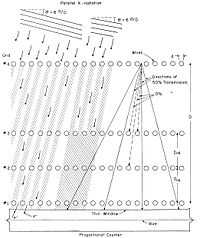
A modulation collimator consists of “two or more wire grids [diffraction gratings] placed in front of an X-ray sensitive Geiger tube or proportional counter.”[105] Relative to the path of incident X-rays (incoming X-rays) the wire grids are placed one beneath the other with a slight offset that produces a shadow of the upper grid over part of the lower grid.[106]
Computers

"The ALMA correlator [shown at right], one of the most powerful supercomputers in the world, has now been fully installed and tested at its remote, high altitude site in the Andes of northern Chile. This view shows lights glowing on some of the racks of the correlator in the ALMA Array Operations Site Techical Building. This photograph shows one of the four quadrants of the correlator. The full system has four identical quadrants, with over 134 million processors, performing up to 17 quadrillion operations per second."[107]
Telescope mounts
“A telescope mount is a mechanical structure which supports a telescope. Telescope mounts are designed to support the mass of the telescope and allow for accurate pointing of the instrument.”[108]
Def. “an object on which another object”[109] is attached for support is called a mount.
Altazimuth mounts
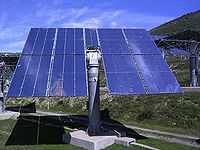
“An altazimuth or alt-azimuth mount is a simple two-axis mount for supporting and rotating an instrument about two mutually perpendicular axes; one vertical and the other horizontal. Rotation about the vertical axis varies the azimuth (compass bearing) of the pointing direction of the instrument. Rotation about the horizontal axis varies the altitude (angle of elevation) of the pointing direction.”[110]
“When used as an astronomical telescope mount, the biggest advantage of an alt-azimuth mount is the simplicity of its mechanical design. The primary disadvantage is its inability to follow astronomical objects in the night sky as the Earth spins on its axis the way that an equatorial mount can. Equatorial mounts only need to be rotated about a single axis, at a constant rate, to follow the rotation of the night sky (diurnal motion). Altazimuth mounts need to be rotated about both axes at variable rates, achieved via microprocessor based two-axis drive systems, to track equatorial motion. This imparts an uneven rotation to the field of view that also has to be corrected via a microprocessor based counter rotation system.[111] On smaller telescopes an equatorial platform[112] is sometimes used to add a third "polar axis" to overcome these problems, providing an hour or more of motion in the direction of right ascension to allow for astronomical tracking. The design also does not allow for the use of mechanical setting circles to locate astronomical objects although modern digital setting circles have removed this shortcoming.”[110]
Equatorial mounts
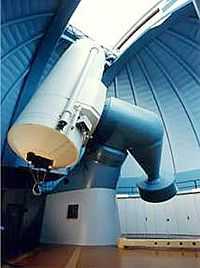
“The equatorial mount has north-south "polar axis" tilted to be parallel to Earth's polar axis that allows the telescope to swing in an east-west arc, with a second axis perpendicular to that to allow the telescope to swing in a north-south arc. Slewing or mechanically driving the mounts polar axis in a counter direction to the Earth's rotation allows the telescope to accurately follow the motion of the night sky.”[113]
Hexapod mounts
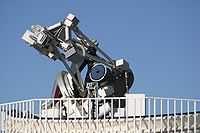
“Instead of the classical mounting using two axles, the mirror is supported by six extendable struts (hexapod). This configuration allows moving the telescope in all six spatial degrees of freedom and also provides a strong structural integrity.”[113]
Clock drives
"[A] Clock drive is a regulatory mechanism used to move an equatorial mounted telescope along one axis to keep the telescope in exact sync with the apparent motion of the celestial sky (diurnal motion).[114]"
"Clock drives work by rotating a telescope mount's polar axis, the axis parallel to the Earth's polar axis (also called the right ascension axis) in the opposite direction to the Earth's rotation one revolution every 23 hours and 56 minutes (called sidereal day), thereby canceling that motion.[115] This allows the telescope to stay [fixed] on a certain point in the sky without having to be constantly re-aimed due to the Earth's rotation. The mechanism itself used to be clockwork but nowadays is usually electrically driven. Clock drives can be light and portable for smaller telescopes[116] or can be exceedingly heavy and complex for larger ones such as the 60 inch telescope at the Mount Wilson Observatory.[117] Clock-driven equatorial platforms are sometimes used in non-tracking type mounts, such as altazimuth mounts.[118]"[119]
Clocks
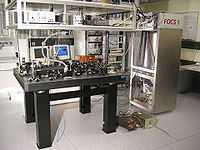
"An atomic clock is a clock device that uses an electronic transition frequency in the microwave, optical, or ultraviolet region[120] of the electromagnetic spectrum of atoms as a frequency standard for its timekeeping element. Atomic clocks are the most accurate time and frequency standards known, and are used as primary standards for international time distribution services, to control the wave frequency of television broadcasts, and in global navigation satellite systems such as GPS."[121]
The FOCS 1 continuous cold cesium fountain atomic clock started operating in 2004 at an uncertainty of one second in 30 million years. The clock is in Switzerland.
Motion calibrators
"POA CALFOS is the improved Post Operational Archive version of the Faint Object Spectrograph (FOS) calibration pipeline ... The current version corrects for image motion problems that have led to significant wavelength scale uncertainties in the FOS data archive. The improvements in the calibration enhance the scientific value of the data in the FOS archive, making it a more homogeneous and reliable resource."[122]
Detectors
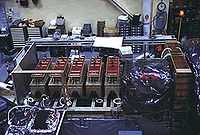
"Radiation detectors provide a signal that is converted to an electric current. The device is designed so that the current provided is proportional to the characteristics of the incident radiation."[123]
Detectors such as the X-ray detector at right collect individual X-rays (photons of X-ray light), count them, discern the energy or wavelength, or how fast they are detected. The detector and telescope system can be designed to yield temporal, spatial, or spectral information.
Image processors
Def. “[a]ny form of information processing for which both the input and output are images”, after Wiktionary image processing, is called image processing.
Def. “[a] representation of anything ... upon canvas, paper, or other surface”, after Wiktionary picture, is called a picture.
Def. a “representation of a real object”, after Wiktionary image is called an image.
Def. “[t]he set of points that map to a given point (or set of points) under a specified function”, from Wiktionary inverse image, is called an inverse image.
“Under the function given by  , the inverse image of 4 is
, the inverse image of 4 is  , as is the inverse image of
, as is the inverse image of  ”, after Wiktionary inverse image.
”, after Wiktionary inverse image.
A telescope's "imaging system's resolution can be limited either by aberration or by diffraction causing blurring of the image. These two phenomena have different origins and are unrelated. Aberrations can be explained by geometrical optics and can in principle be solved by increasing the optical quality — and cost — of the system. On the other hand, diffraction comes from the wave nature of light and is determined by the finite aperture of the optical elements. The lens' circular aperture is analogous to a two-dimensional version of the single-slit experiment. Light passing through the lens interferes with itself creating a ring-shape diffraction pattern, known as the Airy pattern, if the wavefront of the transmitted light is taken to be spherical or plane over the exit aperture."[124]
"The interplay between diffraction and aberration can be characterised by the point spread function (PSF). The narrower the aperture of a lens the more likely the PSF is dominated by diffraction."[124]
"Two point sources are regarded as just resolved when the principal diffraction maximum of one image coincides with the first minimum of the other.[125]"[124]
Robotic telescopes
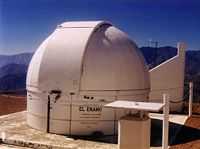
"A robotic telescope is an astronomical telescope and detector system that makes observations without the intervention of a human. In astronomical disciplines, a telescope qualifies as robotic if it makes those observations without being operated by a human, even if a human has to initiate the observations at the beginning of the night, or end them in the morning. A robotic telescope is distinct from a remote telescope, though an instrument can be both robotic and remote."[126]
Spotting telescopes

"A spotting scope is a small portable telescope with added optics to present an erect image, optimized for the observation of terrestrial objects."[127]
"The light-gathering power and [angular] resolution of a spotting scope is determined by the diameter of the objective lens, typically between 50 and 80 mm. The larger the objective, the more massive and expensive the telescope."[127]
"The optical assembly has a small refracting objective lens, an image erecting system that uses either image erecting relay lenses or prisms (porro prisms or roof prisms), and an eyepiece that is usually removable and interchangeable to give different magnifications. Other telescope designs are used such as Schmidt and Maksutov optical assemblies. They may have a ruggedised design, a mounting for attaching to a tripod, and an ergonomically designed and located knob for focus control."[127]
Observatories
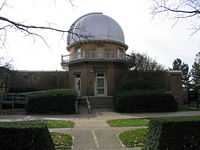
"Historically, observatories [are] as simple as [using or placing stably] an astronomical sextant (for measuring the distance between stars) or Stonehenge (which has some alignments on astronomical phenomena). ... Most optical telescopes are housed within a dome or similar structure, to protect the delicate instruments from the elements. Telescope domes have a slit or other opening in the roof that can be opened during observing, and closed when the telescope is not in use. In most cases, the entire upper portion of the telescope dome can be rotated to allow the instrument to observe different sections of the night sky. Radio telescopes usually do not have domes."[87]
“An equatorial room, in astronomical observatories, is the room which contains an equatorial mounted telescope. It is usually referred to in observatory buildings that contain more than one type of instrument: for example buildings with an "equatorial room" containing an equatorial telescope and a "transit room" containing a transit telescope.[128] Equatorial rooms tend to be large circular rooms to accommodate all the range of motion of a long telescope on an equatorial mount and are usually topped with a dome to keep out the weather.”[129]
Lofting technology
Many devices for lofting technology have been developed to improve radiation astronomy.
Balloons

“The Balloon-borne Large Aperture Submillimeter Telescope (BLAST) is a submillimeter telescope that hangs from a high altitude balloon. It has a 2 meter primary mirror that directs light into bolometer arrays operating at 250, 350, and 500 µm. ... BLAST's primary science goals are:[130]
- Measure photometric redshifts, rest-frame FIR luminosities and star formation rates of high-redshift starburst galaxies, thereby constraining the evolutionary history of those galaxies that produce the FIR/submillimeter background.
- Measure cold pre-stellar sources associated with the earliest stages of star and planet formation.
- Make high-resolution maps of diffuse galactic emission over a wide range of galactic latitudes.”[131]
“High-altitude balloons and aircraft ... can get above [much] of the atmosphere. The BLAST experiment and SOFIA are two examples, respectively, although SOFIA can also handle near infrared observations.”[132]
At left above "NASA's balloon-carried BLAST sub-millimeter telescope is hoisted into launch position on Dec. 25, 2012, at McMurdo Station in Antarctica on a mission to peer into the cosmos."[133] The giant helium-filled balloon is slowly drifting about 36 km above Antarctica. It was "[l]aunched on Tuesday (Dec. 25) from the National Science Foundation's Long Duration Balloon (LDB) facility ... This is the fifth and final mission for BLAST, short for the Balloon-borne Large-Aperture Submillimeter Telescope. ... "BLAST found lots of so-called dark cores in our own Milky Way — dense clouds of cold dust that are supposed to be stars-in-the-making. Based on the number of dark cores, you would expect our galaxy to spawn dozens of new stars each year on average. Yet, the galactic star formation rate is only some four solar masses per year." So why is the stellar birth rate in our Milky Way so low? Astronomers can think of two ways in which a dense cloud of dust is prevented from further contracting into a star: turbulence in the dust, or the collapse-impeding effects of magnetic fields. On its new mission, BLAST should find out which process is to blame. ... [The 1800-kilogram] stratospheric telescope will observe selected star-forming regions in the constellations Vela and Lupus."[134]
Aircraft assisted launches
"The Array of Low Energy X-ray Imaging Sensors (ALEXIS) X-ray telescopes feature curved mirrors whose multilayer coatings reflect and focus low-energy X-rays or extreme ultraviolet light the way optical telescopes focus visible light. ... The Launch was provided by the United States Air Force Space Test Program on a Pegasus Booster on April 25, 1993.[135]"[136]
Research
Hypothesis:
- Ancients had and used telescopes.
Control groups

The findings demonstrate a statistically systematic change from the status quo or the control group.
“In the design of experiments, treatments [or special properties or characteristics] are applied to [or observed in] experimental units in the treatment group(s).[137] In comparative experiments, members of the complementary group, the control group, receive either no treatment or a standard treatment.[138]"[139]
A control group for a radiation telescope would contain
- an aperture, or an entry avenue into the instrument,
- collimators, or lenses, to concentrate radiation,
- moderators, to systematically reduce the incoming radiation so as to allow determination of incoming direction,
- detectors, or sensors, to convert the incoming radiation into electrical impulses,
- amplifiers, or processors, and
- supports, to provide orientation and stability of all components.
Proof of concept
Def. a “short and/or incomplete realization of a certain method or idea to demonstrate its feasibility"[140] is called a proof of concept.
Def. evidence that demonstrates that a concept is possible is called proof of concept.
The proof-of-concept structure consists of
- background,
- procedures,
- findings, and
- interpretation.[141]
Proof of concept consists of a prototype instrument or device that makes a distant source appear nearer.
Proof of technology
"[T]he objective of a proof of technology is to determine the solution to some technical problem, such as how two systems might be integrated or that a certain throughput can be achieved with a given configuration."[142]
Def.
- "[a]n original object or form which is a basis for other objects, forms, or for its models and generalizations",[143]
- "[a]n early sample or model built to test a concept or process",[143] or
- "[a]n instance of a category or a concept that combines its most representative attributes"[143] is called a prototype.
Def. "[t]o test something using the conditions that it was designed to operate under, especially out in the real world instead of in a laboratory or workshop"[144] is called "field-test", or a field test.
A "proof-of-technology prototype ... typically implements one critical scenario to exercise or stress the highest-priority requirements."[145]
"[A] proof-of-technology test demonstrates the system can be used"[146].
"The strongest proof of technology performance is based on consistency among multiple lines of evidence, all pointing to similar levels of risk reduction."[147]
See also
References
- ↑ Institute for Astronomy – University of Hawaii (January 2009). "Mauna Kea Comprehensive Management Plan: UH Management Areas" (PDF). Hawai`i State Department of Land and Natural Resources. Retrieved August 19, 2010.
- ↑ "National Natural Landmark". National Park Service. Retrieved 12 December 2012.
- 1 2 "Mauna Kea, In: Wikipedia". San Francisco, California: Wikimedia Foundation, Inc. February 4, 2013. Retrieved 2013-02-05.
- ↑ "Mauna Kea Telescopes". Institute for Astronomy – University of Hawaii. Retrieved August 29, 2010.
- 1 2 "Radiation, In: Wikipedia". San Francisco, California: Wikimedia Foundation, Inc. May 31, 2012. Retrieved 2012-06-02.
- 1 2 "telescope, In: Wiktionary". San Francisco, California: Wikimedia Foundation, Inc. December 7, 2013. Retrieved 2014-01-03.
- 1 2 "The Telescope". The Galileo Project. Retrieved 5 March 2012.
- ↑ "Aerial telescope, In: Wikipedia". San Francisco, California: Wikimedia Foundation, Inc. August 16, 2012. Retrieved 2012-10-08.
- ↑ Giulio Magli (2009). When the method is lacking, In: Mysteries and Discoveries of Archaeoastronomy from Giza to Easter Island. Rome, Italy: Copernicus Books. pp. 97-116. doi:10.1007/978-0-387-76566-2_5. ISBN 978-0-387-76564-8.
- 1 2 McGraw-Hill Encyclopedia of Science and Technology (5th ed.). McGraw-Hill. 1993.
- ↑ "Optics, In: Wikipedia". San Francisco, California: Wikimedia Foundation, Inc. July 1, 2012. Retrieved 2012-07-07.
- ↑ Jane Luu and David Jewitt (November 1996). "Color Diversity among the Centaurs and Kuiper Belt Objects". The Astronomical Journal 112 (5): 2310-8. http://adsabs.harvard.edu/full/1996AJ....112.2310L. Retrieved 2013-11-05.
- ↑ "Quartz, In: Wikipedia". San Francisco, California: Wikimedia Foundation, Inc. August 29, 2012. Retrieved 2012-09-03.
- ↑ Typhoon Lee, Frank H. Shu and Hsien Shang, Alfred E. Glassgold and K. E. Rehm (October 20, 1998). "Protostellar cosmic rays and extinct radioactivities in meteorites". The Astrophysical Journal 506 (2): 898-912. doi:10.1086/306284. http://iopscience.iop.org/0004-637X/506/2/898. Retrieved 2013-11-04.
- ↑ "How do you determine the effects of a solar flare that took place 150 years ago?". Stuart Clarks Universe. Retrieved May 23, 2012.
- ↑ Kenneth G. McCracken, G. A. M. Dreschhoff, E. J. Zeller, D. F. Smart, M. A. Shea (2001). "Solar cosmic ray events for the period 1561–1994 1. Identification in polar ice, 1561–1950". Journal of Geophysical Research 106 (A10): 21,585–21,598. doi:10.1029/2000JA000237. http://www.agu.org/pubs/crossref/2001/2000JA000237.shtml. Retrieved February 16, 2011.
- ↑ "Solar storm of 1859, In: Wikipedia". San Francisco, California: Wikimedia Foundation, Inc. September 1, 2012. Retrieved 2012-09-01.
- ↑ "Soda Lime Glass Transmission Curve".
- ↑ "B270-Superwite Glass Transmission Curve".
- ↑ "Selected Float Glass Transmission Curve".
- ↑ "Ultraviolet, In: Wikipedia". San Francisco, California: Wikimedia Foundation, Inc. June 26, 2012. Retrieved 2012-06-26.
- ↑ "telescopy, In: Wiktionary". San Francisco, California: Wikimedia Foundation, Inc. April 1, 2013. Retrieved 2013-07-21.
- ↑ "radiotelescopy, In: Wiktionary". San Francisco, California: Wikimedia Foundation, Inc. April 2, 2013. Retrieved 2013-07-21.
- ↑ I. Bertini, N. Thomas, and C. Barbieri (January 2007). "Modeling of the light scattering properties of cometary dust using fractal aggregates". Astronomy & Astrophysics 461 (1): 351-64. doi:10.1051/0004-6361:20065461. http://www.aanda.org/articles/aa/full/2007/01/aa5461-06/aa5461-06.html. Retrieved 2011-12-08.
- 1 2 "Background (astronomy), In: Wikipedia". San Francisco, California: Wikimedia Foundation, Inc. October 7, 2010. Retrieved 2013-05-03.
- ↑ "High Energy Astronomy Observatory 3, In: Wikipedia". San Francisco, California: Wikimedia Foundation, Inc. October 4, 2012. Retrieved 2012-12-05.
- ↑ F. B. McDonald, B. J. Teegarden, and J. H. Trainor and W. R. Webber (February 1. 1974). "The anomalous abundance of cosmic-ray nitrogen and oxygen nuclei at low energies". The Astrophysical Journal 187 (02): L105-8. doi:10.1086/181407. http://adsabs.harvard.edu/full/1974ApJ...187L.105M. Retrieved 2012-12-05.
- 1 2 W. N. Johnson (November 1996). "Appendix G to the NASA RESEARCH ANNOUNCEMENT for the COMPTON GAMMA RAY OBSERVATORY GUEST INVESTIGATOR PROGRAM". Greenbelt, Maryland USA: National Aeronautics and Space Administration Goddard Space Flight Center. Retrieved 2013-04-05.
- ↑ Donald J. Williams (May 14, 2012). "Energetic Particles Detector (EPD)". Greenbelt, Maryland USA: NASA Goddard Space Flight Center. Retrieved 2012-08-11.
- ↑ G. Weidenspointner, G.K. Skinner, P. Jean, J. Knödlseder, P. von Ballmoos, R. Diehl, A. Strong, B. Cordier, S. Schanne, C. Winkler (October 2008). "Positron astronomy with SPI/INTEGRAL". New Astronomy Reviews 52 (7-10): 454-6. doi:10.1016/j.newar.2008.06.019. http://www.sciencedirect.com/science/article/pii/S1387647308001164. Retrieved 2011-11-25.
- ↑ "ANTARES (telescope), In: Wikipedia". San Francisco, California: Wikimedia Foundation, Inc. July 4, 2012. Retrieved 2012-08-23.
- ↑ R. Abbasi et al. (IceCube Collaboration) (2010). "Calibration and Characterization of the IceCube Photomultiplier Tube". Nuclear Instruments and Methods A 618: 139–152. doi:10.1016/j.nima.2010.03.102.
- ↑ R. Abbasi et al. (IceCube Collaboration) (2009). "The IceCube Data Acquisition System: Signal Capture, Digitization, and Timestamping". Nuclear Instruments and Methods A 601: 294–316. doi:10.1016/j.nima.2009.01.001.
- ↑ IceCube Neutrino Observatory
- ↑ "IceCube Neutrino Observatory, In: Wikipedia". San Francisco, California: Wikimedia Foundation, Inc. August 10, 2012. Retrieved 2012-08-23.
- ↑ "Compton Gamma Ray Observatory, In: Wikipedia". San Francisco, California: Wikimedia Foundation, Inc. March 26, 2013. Retrieved 2013-04-05.
- ↑ Neil Gehrels (August 1, 2005). "The Imaging Compton Telescope (COMPTEL)". Greenbelt, Maryland USA: NASA Goddard Space Flight Center. Retrieved 2013-04-05.
- ↑ "Fermi Gamma-ray Space Telescope, In: Wikipedia". San Francisco, California: Wikimedia Foundation, Inc. June 9, 2012. Retrieved 2012-06-10.
- 1 2 3 4 Tim Wogan (May 9, 2012). "Silicon 'prism' bends gamma rays". Institute of Physics. Retrieved 2013-05-09.
- ↑ Dietrich Habs (May 9, 2012). "Silicon 'prism' bends gamma rays". Institute of Physics. Retrieved 2013-05-09.
- ↑ Norbert Pietralla (May 9, 2012). "Silicon 'prism' bends gamma rays". Institute of Physics. Retrieved 2013-05-09.
- ↑ "X-ray telescope, In: Wikipedia". San Francisco, California: Wikimedia Foundation, Inc. April 17, 2012. Retrieved 2012-06-15.
- ↑ Kulinder Pal Singh. "Techniques in X-ray Astronomy" (pdf). Archived from the original on 2012-09-19.
- ↑ Hans Wolter (1952). "Glancing Incidence Mirror Systems as Imaging Optics for X-rays". Ann. Physik 10: 94.
- ↑ Hans Wolter (1952). "A Generalized Schwarschild Mirror Systems For Use at Glancing Incidence for X-ray Imaging". Ann. Physik 10: 286.
- ↑ Rob Petre. "X-ray Imaging Systems". NASA.
- ↑ "Wolter telescope, In: Wikipedia". San Francisco, California: Wikimedia Foundation, Inc. February 20, 2012. Retrieved 2012-06-15.
- ↑ "Hubble Space Telescope, In: Wikipedia". San Francisco, California: Wikimedia Foundation, Inc. January 21, 2013. Retrieved 2013-01-22.
- ↑ John W. Hardy (June 1977). Active optics: A new technology for the control of light. Proceedings of the IEEE. pp. 110. http://oai.dtic.mil/oai/oai?verb=getRecord&metadataPrefix=html&identifier=ADA339170.
- 1 2 "Active optics, In: Wikipedia". San Francisco, California: Wikimedia Foundation, Inc. 12 October 2014. Retrieved 2014-12-25.
- ↑ "adaptive optics, In: Wiktionary". San Francisco, California: Wikimedia Foundation, Inc. 16 June 2013. Retrieved 2014-12-25.
- ↑ François Roddier, ed (1999). Adaptive Optics in Astronomy. Cambridge, United Kingdom: Cambridge University Press. pp. 411. ISBN 0 521 55375 X. http://books.google.com/books?hl=en&lr=&id=4n5tBN21LRsC&oi=fnd&pg=PP1&ots=7FUaBW-y4B&sig=1NLsHH3qkTKN4yA4dD1C5YqxZhg. Retrieved 2012-02-15.
- ↑ AH Tunnacliffe, JG Hirst (1996). Optics. Kent, England. pp. 233–7. ISBN 0-900099-15-1.
- 1 2 "Refracting telescope, In: Wikipedia". San Francisco, California: Wikimedia Foundation, Inc. July 7, 2012. Retrieved 2012-07-07.
- ↑ "Reflecting telescope, In: Wikipedia". San Francisco, California: Wikimedia Foundation, Inc. July 2, 2012. Retrieved 2012-07-07.
- ↑ "catadioptric, In: Wiktionary". San Francisco, California: Wikimedia Foundation, Inc. 9 October 2013. Retrieved 2014-12-25.
- ↑ "catadioptrics, In: Wiktionary". San Francisco, California: Wikimedia Foundation, Inc. 9 October 2013. Retrieved 2014-12-25.
- ↑ Jack Newton, Philip Teece - "The Guide to Amateur Astronomy" - Page 287
- ↑ Timothy Ferris "Seeing in the Dark" - Page 39
- ↑ "Dobsonian telescope, In: Wikipedia". San Francisco, California: Wikimedia Foundation, Inc. December 20, 2013. Retrieved 2014-01-03.
- ↑ "Schmidt camera, In: Wikipedia". San Francisco, California: Wikimedia Foundation, Inc. December 30, 2013. Retrieved 2014-01-03.
- ↑ John J. G. Savard. "'Miscellaneous Musings".
- ↑ "Maksutov telescope, In: Wikipedia". San Francisco, California: Wikimedia Foundation, Inc. December 9, 2013. Retrieved 2014-01-03.
- 1 2 3 4 "Extreme ultraviolet Imaging Telescope, In: Wikipedia". San Francisco, California: Wikimedia Foundation, Inc. December 28, 2012. Retrieved 2013-07-24.
- ↑ Antony Cooke (2005). Visual Astronomy Under Dark Skies: A New Approach to Observing Deep Space. London: Springer-Verlag. pp. 180. ISBN 1852339012. http://books.google.com/books?id=SXmrBfl4H3sC&dq=entity+astronomy&lr=&source=gbs_navlinks_s. Retrieved 2011-11-06.
- 1 2 "Astronomical filter, In: Wikipedia". San Francisco, California: Wikimedia Foundation, Inc. July 18, 2012. Retrieved 2012-07-29.
- 1 2 3 4 5 "Ritchey–Chrétien telescope, In: Wikipedia". San Francisco, California: Wikimedia Foundation, Inc. May 22, 2013. Retrieved 2013-07-24.
- ↑ Warren J. Smith (2008). Modern Optical Engineering (4th ed.). McGraw-Hill Professional. pp. 508–10. ISBN 978-0-07-147687-4.
- ↑ "Alma telescope: Ribbon cut on astronomical giant". BBC. Retrieved 13 March 2013.
- ↑ "Atacama Large Millimeter Array, In: Wikipedia". San Francisco, California: Wikimedia Foundation, Inc. July 8, 2013. Retrieved 2013-07-21.
- ↑ "Heinrich Hertz Submillimeter Telescope, In: Wikipedia". San Francisco, California: Wikimedia Foundation, Inc. May 5, 2012. Retrieved 2012-08-04.
- ↑ SemperBlotto (4 September 2015). "radio telescope, In: Wiktionary". San Francisco, California: Wikimedia Foundation, Inc. Retrieved 2015-09-18.
- ↑ "Radio telescope, In: Wikipedia". San Francisco, California: Wikimedia Foundation, Inc. 29 January 2015. Retrieved 2015-02-03.
- ↑ David T. Chuss (April 18, 2008). "The Planck Mission". Greenbelt, Maryland USA: Goddard Space Flight Center. Retrieved 2013-12-12.
- 1 2 David Brand (21 January 2003). "Astrophysicist Robert Brown, leader in telescope development, named to head NAIC and its main facility, Arecibo Observatory". Cornell University. Retrieved 2008-09-02.
- ↑ "Arecibo Observatory, In: Wikipedia". San Francisco, California: Wikimedia Foundation, Inc. December 8, 2012. Retrieved 2012-12-09.
- 1 2 "Astronomical interferometer, In: Wikipedia". San Francisco, California: Wikimedia Foundation, Inc. August 2, 2012. Retrieved 2012-08-29.
- ↑ Margaret J. Penston (14 August 2002). "The electromagnetic spectrum". Particle Physics and Astronomy Research Council. Retrieved 17 August 2006.
- ↑ "Astronomy, In: Wikipedia". San Francisco, California: Wikimedia Foundation, Inc. July 19, 2012. Retrieved 2012-07-28.
- ↑ "Hall effect thruster, In: Wikipedia". San Francisco, California: Wikimedia Foundation, Inc. May 16, 2013. Retrieved 2013-05-28.
- 1 2 "Sun Gun Telescope, In: Wikipedia". San Francisco, California: Wikimedia Foundation, Inc. December 2, 2013. Retrieved 2014-01-03.
- 1 2 "Liquid mirror telescope, In: Wikipedia". San Francisco, California: Wikimedia Foundation, Inc. October 1, 2013. Retrieved 2014-01-03.
- 1 2 "Solar telescope, In: Wikipedia". San Francisco, California: Wikimedia Foundation, Inc. December 30, 2013. Retrieved 2014-01-03.
- 1 2 "NASA Orbital Debris Observatory, In: Wikipedia". San Francisco, California: Wikimedia Foundation, Inc. May 6, 2013. Retrieved 2014-01-03.
- ↑ Mario Blanco Cazas, "Informe Laboratorio de Rayos X — FRX-DRX" (in Spanish), Universidad Mayor de San Andres, Facultad de Ciencias Geologicas, Instituto de Investigaciones Geologicas y del Medio Ambiente, La Paz, Bolivia, September 20, 2007. Retrieved October 10, 2007.
- ↑ "2007 Carancas impact event, In: Wikipedia". San Francisco, California: Wikimedia Foundation, Inc. April 26, 2013. Retrieved 2013-05-12.
- 1 2 "Observatory, In: Wikipedia". San Francisco, California: Wikimedia Foundation, Inc. January 26, 2013. Retrieved 2013-02-05.
- ↑ "Astronomical spectroscopy, In: Wikipedia". San Francisco, California: Wikimedia Foundation, Inc. December 8, 2012. Retrieved 2013-01-09.
- ↑ "GoTo (telescopes), In: Wikipedia". San Francisco, California: Wikimedia Foundation, Inc. May 27. 2013. Retrieved 2014-01-03.
- ↑ Clyde W. Tombaugh. "The Struggles to Find the Ninth Planet".
- ↑ "Astrograph, In: Wikipedia". San Francisco, California: Wikimedia Foundation, Inc. December 12, 2013. Retrieved 2014-01-03.
- ↑ "Comet seeker, In: Wikipedia". San Francisco, California: Wikimedia Foundation, Inc. March 6, 2013. Retrieved 2014-01-03.
- 1 2 "Meridian circle, In: Wikipedia". San Francisco, California: Wikimedia Foundation, Inc. November 6, 2013. Retrieved 2014-01-03.
- ↑ "About NOFS telescopes".
- ↑ Stone, Ronald C.; Monet, David G. (1990). "The USNO (Flagstaff Station) CCD Transit Telescope and Star Positions Measured From Extragalactic Sources". Proceedings of IAU Symposium No. 141. pp. 369–370.
- 1 2 "Large Binocular Telescope, In: Wikipedia". San Francisco, California: Wikimedia Foundation, Inc. May 21, 2013. Retrieved 2013-07-02.
- ↑ Pascal Fortin (April 14 2013). "VERITAS Very Energetic Radiation Imaging Telescope Array System". Amado, Arizona USA: Smithsonian Astrophysical Observatory. Retrieved 2013-06-01.
- ↑ "The CANGAROO Project". The University of Adelaide. Retrieved 17 September 2011.
- ↑ "Institute for Cosmic Ray Research, In: Wikipedia". San Francisco, California: Wikimedia Foundation, Inc. April 28, 2013. Retrieved 2013-06-01.
- ↑ "Very Large Telescope, In: Wikipedia". San Francisco, California: Wikimedia Foundation, Inc. June 17, 2013. Retrieved 2013-07-02.
- 1 2 "X-ray telescope, In: Wikipedia". San Francisco, California: Wikimedia Foundation, Inc. April 17, 2012. Retrieved 2012-06-15.
- ↑ "Mirror Laboratory".
- 1 2 3 NuStar: Instrumentation: Optics
- ↑ "History of the telescope, In: Wikipedia". San Francisco, California: Wikimedia Foundation, Inc. June 10, 2012. Retrieved 2012-06-26.
- ↑ H. Bradt, G. Garmire, M. Oda, G. Spada, and B.V. Sreekantan, P. Gorenstein and H. Gursky (September 1968). "The Modulation Collimator in X-ray Astronomy". Space Science Reviews 8 (4): 471-506. doi:10.1007/BF00175003.
- ↑ Minoru Oda (January 1965). "High-Resolution X-Ray Collimator with Broad Field of View for Astronomical Use". Applied Optics 4 (1): 143. doi:10.1364/AO.4.000143. http://www.opticsinfobase.org/abstract.cfm?URI=ao-4-1-143. Retrieved 2011-12-10.
- ↑ ALMA Observatory (July 10, 2013). "Lights glowing on the ALMA correlator". Atacama, chile: ALMA Observatory Organization. Retrieved 2013-07-21.
- ↑ "Telescope, In: Wikipedia". San Francisco, California: Wikimedia Foundation, Inc. July 4, 2012. Retrieved 2012-07-07.
- ↑ "mount, In: Wiktionary". San Francisco, California: Wikimedia Foundation, Inc. June 8, 2012. Retrieved 2012-07-07.
- 1 2 "Altazimuth mount, In: Wikipedia". San Francisco, California: Wikimedia Foundation, Inc. 17 January 2014. Retrieved 2015-02-03.
- ↑ H. S. Mahra, B. N. Karkera (1985). "Field rotation with altazimuth mounting telescope". Bulletin of the Astronomical Society of India 13: 88.
- ↑ Reiner Vogel (2007). "Circle Segment Platform (link from his English language page)". Retrieved 13 March 2011.
- 1 2 "Telescope mount, In: Wikipedia". San Francisco, California: Wikimedia Foundation, Inc. 21 September 2014. Retrieved 2015-02-03.
- ↑ "Definition".
- ↑ Guy Consolmagno, Dan M. Davis, Karen Kotash Sepp, Anne Drogin, Mary Lynn Skirvin. Turn left at Orion: a hundred night sky objects to see in a small telescope .... pp. 204. http://books.google.com/books?id=PexKTfPy3voC&pg=PA204&dq=%22called+a+clock+drive%22&hl=en&ei=etnITMabMIH_8Aa8v8StDw&sa=X&oi=book_result&ct=result&resnum=10&ved=0CFEQ6AEwCQ#v=onepage&q=%22called%20a%20clock%20drive%22&f=false.
- ↑ Jerry Oltion. "The Trackball Mount". Retrieved 13 March 2011.
- ↑ "60 inch clock (the old Mount Wilson telescope clock drive)".
- ↑ Reiner Vogel (2007). "Circle Segment Platform (link from his English language page)". Retrieved 13 March 2011.
- ↑ "Clock drive, In: Wikipedia". San Francisco, California: Wikimedia Foundation, Inc. May 30, 2012. Retrieved 2012-07-07.
- ↑ Dennis McCarthy, P. Kenneth Seidelmann (2009). TIME from Earth Rotation to Atomic Physics. Weinheim: Wiley-VCH. ch. 10 & 11.
- ↑ "Atomic clock, In: Wikipedia". San Francisco, California: Wikimedia Foundation, Inc. October 12, 2012. Retrieved 2012-10-24.
- ↑ "POA CALFOS, In: Wikipedia". San Francisco, California: Wikimedia Foundation, Inc. July 22 2012. Retrieved 2012-12-23.
- ↑ "Radiation detectors, In: Wikipedia". San Francisco, California: Wikimedia Foundation, Inc. June 19, 2012. Retrieved 2012-07-07.
- 1 2 3 "Angular resolution, In: Wikipedia". San Francisco, California: Wikimedia Foundation, Inc. October 20, 2012. Retrieved 2013-01-10.
- ↑ Max Born and Emil Wolf (October 1999). Principles of Optics. Cambridge: Cambridge University Press. p. 461. ISBN 0-521-64222-1.
- ↑ "Robotic telescope, In: Wikipedia". San Francisco, California: Wikimedia Foundation, Inc. July 1, 2013. Retrieved 2014-01-03.
- 1 2 3 "article title, In: Wikipedia". San Francisco, California: Wikimedia Foundation, Inc. February 28, 2013. Retrieved 2014-01-03.
- ↑ "The CHABOT Observatory". Publications of the Astronomical Society of the Pacific 6 (35): 85. http://adsabs.harvard.edu/full/1894PASP....6...85B.
- ↑ "Equatorial room, In: Wikipedia". San Francisco, California: Wikimedia Foundation, Inc. May 14, 2012. Retrieved 2012-07-07.
- ↑ BLAST Public Webpage
- ↑ "BLAST (telescope), In: 'Wikipedia". San Francisco, California: Wikimedia Foundation, Inc. February 4, 2012. Retrieved 2012-06-08.
- ↑ "Submillimetre astronomy, In: Wikipedia". San Francisco, California: Wikimedia Foundation, Inc. June 2, 2012. Retrieved 2012-06-08.
- ↑ SPACE.com (December 25, 2012). "NASA Launches Telescope-Toting Balloon from Antarctica on Christmas". SPACE.com. Retrieved 2012-12-26.
- ↑ Govert Schilling (December 26, 2012). "NASA Launches Telescope-Toting Balloon from Antarctica on Christmas". McMurdo Station: SPACE.com. Retrieved 2012-12-26.
- ↑ "ALEXIS satellite marks fifth anniversary of launch". Los Alamos National Laboratory. 23 April 1998. Retrieved 17 August 2011.
- ↑ "Array of Low Energy X-ray Imaging Sensors, In: Wikipedia". San Francisco, California: Wikimedia Foundation, Inc. December 18, 2011. Retrieved 2012-12-09.
- ↑ Klaus Hinkelmann, Oscar Kempthorne (2008). Design and Analysis of Experiments, Volume I: Introduction to Experimental Design (2nd ed.). Wiley. ISBN 978-0-471-72756-9. http://books.google.com/?id=T3wWj2kVYZgC&printsec=frontcover.
- ↑ R. A. Bailey (2008). Design of comparative experiments. Cambridge University Press. ISBN 978-0-521-68357-9. http://www.cambridge.org/uk/catalogue/catalogue.asp?isbn=9780521683579.
- ↑ "Treatment and control groups, In: Wikipedia". San Francisco, California: Wikimedia Foundation, Inc. May 18, 2012. Retrieved 2012-05-31.
- ↑ "proof of concept, In: Wiktionary". San Francisco, California: Wikimedia Foundation, Inc. November 10, 2012. Retrieved 2013-01-13.
- ↑ Ginger Lehrman and Ian B Hogue, Sarah Palmer, Cheryl Jennings, Celsa A Spina, Ann Wiegand, Alan L Landay, Robert W Coombs, Douglas D Richman, John W Mellors, John M Coffin, Ronald J Bosch, David M Margolis (August 13, 2005). "Depletion of latent HIV-1 infection in vivo: a proof-of-concept study". Lancet 366 (9485): 549-55. doi:10.1016/S0140-6736(05)67098-5. http://www.ncbi.nlm.nih.gov/pmc/articles/PMC1894952/. Retrieved 2012-05-09.
- ↑ "Proof of concept, In: Wikipedia". San Francisco, California: Wikimedia Foundation, Inc. December 27, 2012. Retrieved 2013-01-13.
- 1 2 3 "prototype, In: Wiktionary". San Francisco, California: Wikimedia Foundation, Inc. December 8, 2013. Retrieved 2014-01-03.
- ↑ "field-test, In: Wiktionary". San Francisco, California: Wikimedia Foundation, Inc. August 5, 2012. Retrieved 2013-01-13.
- ↑ A. Liu; I. Gorton (March/April 2003). "Accelerating COTS middleware acquisition: the i-Mate process". Software, IEEE 20 (2): 72-9. doi:10.1109/MS.2003.1184171. http://cin.ufpe.br/~redis/intranet/bibliography/middleware/liu-cots03.pdf. Retrieved 2012-02-15.
- ↑ Rhea Wessel (January 25, 2008). "Cargo-Tracking System Combines RFID, Sensors, GSM and Satellite". RFID Journal: 1-2. http://www.rfidjournal.com/article/pdf/3870/1/1/rfidjournal-article3870.PDF. Retrieved 2012-02-15.
- ↑ P. Suresh, C. Rao, M.D. Annable and J.W. Jawitz (August 2000). E. Timothy Oppelt. ed. [http://www.afcee.af.mil/shared/media/document/AFD-071003-081.pdf#page=108 In Situ Flushing for Enhanced NAPL Site Remediation: Metrics for Performance Assessment, In: Abiotic In Situ Technologies for Groundwater Remediation Conference]. Cincinnati, Ohio: U.S. Environmental Protection Agency. pp. 105. http://www.afcee.af.mil/shared/media/document/AFD-071003-081.pdf#page=108. Retrieved 2012-02-15.
External links
- African Journals Online
- Bing Advanced search
- Google Books
- Google scholar Advanced Scholar Search
- International Astronomical Union
- JSTOR
- Lycos search
- NASA/IPAC Extragalactic Database - NED
- NASA's National Space Science Data Center
- NCBI All Databases Search
- NCBI Site Search
- Office of Scientific & Technical Information
- PubChem Public Chemical Database
- Questia - The Online Library of Books and Journals
- SAGE journals online
- The SAO/NASA Astrophysics Data System
- Scirus for scientific information only advanced search
- SDSS Quick Look tool: SkyServer
- SIMBAD Astronomical Database
- Spacecraft Query at NASA.
- SpringerLink
- Taylor & Francis Online
- Universal coordinate converter
- Wiley Online Library Advanced Search
- Yahoo Advanced Web Search
| |||||||||||||||||||||||||||||
| |||||||||||||||||||||||||||||||||||||||||
![]() This is a research project at http://en.wikiversity.org
This is a research project at http://en.wikiversity.org
| |
Development status: this resource is experimental in nature. |
| |
Resource type: this resource is an article. |
| |
Resource type: this resource contains a lecture or lecture notes. |
| |
Subject classification: this is an astronomy resource. |
| |
Subject classification: this is a materials science resource. |
| |
Subject classification: this is a technology resource . |



![K_2 = -1 - \frac{2}{(M - 1)^3}\left[M(2M - 1) + \frac{B}{D}\right]](../I/m/24a1b52597dfab18ad80bcd76a2bf185.png)
